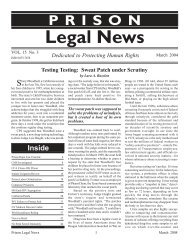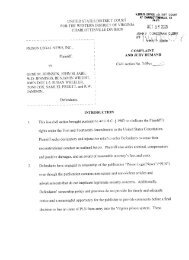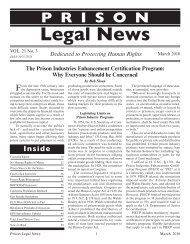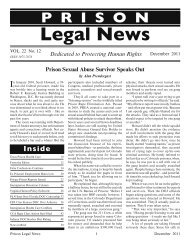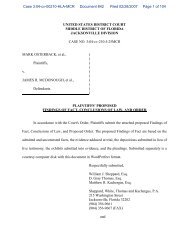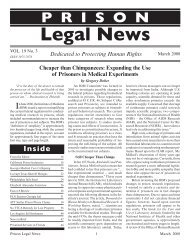From the Editor - Prison Legal News
From the Editor - Prison Legal News
From the Editor - Prison Legal News
Create successful ePaper yourself
Turn your PDF publications into a flip-book with our unique Google optimized e-Paper software.
Over <strong>the</strong> years, PLN has frequently<br />
reported on <strong>the</strong> efforts of legislators<br />
and prisoncrats to seize money from<br />
prisoners, <strong>the</strong> vast majority of whom are<br />
poor. This trend has sharply accelerated<br />
in recent years. The cover story of this issue<br />
of PLN is excerpted from <strong>the</strong> recent<br />
PLN anthology, <strong>Prison</strong> Profiteers: Who<br />
Makes Money from Mass Incarceration,<br />
published earlier this year by <strong>the</strong> New<br />
Press. The book is available from PLN<br />
and documents <strong>the</strong> growing practice of<br />
fur<strong>the</strong>r impoverishing and penalizing<br />
those enmeshed in <strong>the</strong> criminal justice<br />
system. Kristen Levingston does a great<br />
job showing how <strong>the</strong>se efforts to fur<strong>the</strong>r<br />
immiserate <strong>the</strong> poor only make a bad situation<br />
worse. If you like this article I hope<br />
you consider reading <strong>the</strong> entire book,<br />
it’s well worth <strong>the</strong> read as we show who’s<br />
benefitting from policies of mass imprisonment.<br />
Not just who is harmed. <strong>Prison</strong><br />
Profiteers is available from PLN and fine<br />
book sellers everywhere. Only PLN has<br />
<strong>the</strong> paperback edition at this time.<br />
I would like to thank everyone who<br />
donated to PLN’s annual fundraiser this<br />
year. We extended it to <strong>the</strong> end of March<br />
as our mailing was delayed going out. I<br />
will report <strong>the</strong> outcome in next month’s<br />
editorial once we have added up <strong>the</strong> results.<br />
All support, whe<strong>the</strong>r large or small,<br />
is much needed and appreciated. <strong>Prison</strong>er<br />
readers who have not yet returned <strong>the</strong>ir<br />
surveys should do so as soon as possible<br />
so we can tabulate <strong>the</strong> results. We want to<br />
know what you think of PLN and how we<br />
can better serve your needs.<br />
Among our goals for this year are<br />
expanding PLN’s size to bring readers<br />
even more news and information. But we<br />
want to make sure we can sustain it and<br />
not have to cut back in size. We are also<br />
working hard to expand our readership.<br />
The more subscribers PLN has <strong>the</strong> lower<br />
our per issue cost is. Between now and <strong>the</strong><br />
end of July we are running our subscription<br />
madness sale. Buy gift subscriptions<br />
of PLN for non subscribers as an introductory<br />
offer and get low prices! It costs<br />
a lot of money and takes a lot of time to<br />
do sample mailings of PLN to potential<br />
subscribers. By letting readers buy introductory<br />
gift subscriptions for potential<br />
subscribers we pass <strong>the</strong> savings on. If <strong>the</strong>re<br />
is someone you think might be interested<br />
in PLN, buy <strong>the</strong>m a gift subscription and<br />
April 2008<br />
<strong>From</strong> <strong>the</strong> <strong>Editor</strong><br />
by Paul Wright<br />
<strong>the</strong>y can check us out. Potential subscribers<br />
include legislators, judges, journalists,<br />
family members, prisoners, pen pals, and<br />
anyone else interested in <strong>the</strong> criminal<br />
justice system in general and prisons in<br />
particular.<br />
14<br />
Expanding <strong>the</strong> number of advertisers<br />
we have is ano<strong>the</strong>r way we can grow in size.<br />
If you patronize PLN advertisers, let <strong>the</strong>m<br />
know you saw <strong>the</strong>ir ad in PLN.<br />
Enjoy this issue of PLN and please<br />
encourage o<strong>the</strong>rs to subscribe!<br />
Buried Alive: Solitary Confinement<br />
in Arizona’s <strong>Prison</strong>s and Jails<br />
Review by David M. Reutter<br />
here have been a couple of<br />
“Ttimes that I’ve tried to end<br />
my life in here, but <strong>the</strong>y keep reviving me<br />
and bringing me back. When I asked why,<br />
I was told, “You’re not going to die on us;<br />
we’re not through punishing you.”<br />
That quote is part of <strong>the</strong> prisoner<br />
testimony in a report published by American<br />
Friends Service Committee (AFSC)<br />
Arizona. The report is a critical evaluation<br />
of solitary confinement in Arizona<br />
prisons and jails. The key findings are<br />
that prisoners in supermax units have<br />
higher rates of mental illness, those units<br />
damage prisoner’s mental health, <strong>the</strong>y do<br />
not reduce prison violence, and <strong>the</strong> units<br />
increase recidivism.<br />
This report is a compelling presentation<br />
that is of interest to anyone in <strong>the</strong><br />
nation with an interest in supermax confinement<br />
conditions and its effects. The<br />
uniqueness of this comprehensive report<br />
is that it is a compilation of governmental<br />
statistics and mainstream media investigative<br />
reports into <strong>the</strong> supermax phenomena.<br />
While <strong>the</strong> report focuses on <strong>the</strong> conditions<br />
of solitary confinement in Arizona, <strong>the</strong><br />
material could be used to dissect any prison<br />
system’s solitary confinement unit.<br />
In fact, that is <strong>the</strong> long term goal<br />
of AFSC. The report is part of AFSC’s<br />
Stopmax national campaign and launches<br />
<strong>the</strong> stopmax Arizona campaign. It focuses<br />
on solitary confinement in <strong>the</strong> Arizona<br />
Department of Corrections (ADOC), <strong>the</strong><br />
Arizona Department of Juvenile Corrections<br />
(ADJC), and <strong>the</strong> Maricopa county<br />
Fourth Avenue Jail.<br />
The first supermax unit was established<br />
in 1972 at <strong>the</strong> U.S. Penitentiary<br />
in Marion, Illinois. By 1985, <strong>the</strong>re were<br />
about half a dozen such units. By 1997,<br />
45 states, <strong>the</strong> federal Bureau of <strong>Prison</strong>s,<br />
and <strong>the</strong> District of Columbia were operating<br />
control units that house prisoners in<br />
a cell about <strong>the</strong> size of a bathroom for at<br />
least 23 hours a day. In 2002, over 20,000<br />
prisoners, almost 2 percent of <strong>the</strong> U.S.<br />
prison population was being held in long<br />
term solitary confinement.<br />
The report finds <strong>the</strong> investigation<br />
of supermax prisons is needed because<br />
of its effect on community life. “Most<br />
people are aware of research documenting<br />
<strong>the</strong> arrested developments of infants in<br />
orphanages in which <strong>the</strong>y are rarely held<br />
or cuddled. Studies have likewise documented<br />
how adults in sensory deprivation<br />
environments such as prisoners of war<br />
or scientists living in extremely remote<br />
areas begin to develop a discrete set of<br />
emotional and psychological symptoms,”<br />
<strong>the</strong> report states.<br />
The use of supermax prisoners in<br />
America has been condemned by <strong>the</strong><br />
international community. “In May 2000,<br />
<strong>the</strong> U.N. Committee against torture called<br />
<strong>the</strong> ‘excessively harsh regime’ of supermax<br />
prisons a violation of <strong>the</strong> Convention<br />
Against Torture and made it clear that <strong>the</strong><br />
practice is widespread in <strong>the</strong> US,” says <strong>the</strong><br />
report. The isolation of supermax makes<br />
<strong>the</strong> use of torture tools such as physical<br />
restraints, chemical agents, stun guns, and<br />
o<strong>the</strong>r forms of cruelty easily hidden.<br />
One thing prison officials would like<br />
to keep hidden is <strong>the</strong> high rate of mentally<br />
ill in solitary confinement. According to<br />
ADOC statistics, 16.8 percent of <strong>the</strong><br />
prisoner population is mentally ill. Yet, 26<br />
percent of prisoner in ADOC supermax<br />
prisons are mentally ill. Between 25 to 35<br />
percent of ADJC prisoners are mentally<br />
ill, with up to 50 percent of juveniles under<br />
its care taking psychotropic medications.<br />
Because <strong>the</strong> mentally ill cannot fully<br />
comprehend <strong>the</strong> expectations of complex<br />
prison rules or <strong>the</strong> consequences, <strong>the</strong>y<br />
<strong>Prison</strong> <strong>Legal</strong> <strong>News</strong>



